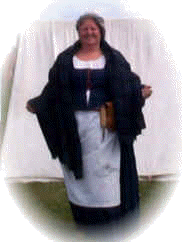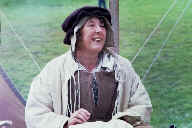
- The Siege group
- Home
- Who we are
- Living History
- On the Camp
- Costume
- 2007 Events
- News
- Membership info
- Picture Gallery
- Contact us
- Links
- Yahoo Group
- Site Credits
- The 17th Century
- Music
- Cookery
- Handicrafts
- Children
- Games
- Weaponry
- The Civil War
Costume
Re-enacting the seventeenth century the Siege Group way means a good deal of attention to detail is needed. All the clothing and other props used at our events are as authentic to the time as it is possible to get.
Garments
Most of the garments for our 17th century re-enactments are produced by members who research authentic style, cloth and colour. Garments can also be bought ready-made from traders who also supply other re-enactment societies. These suppliers occasionally have a 'traders market' where we can buy new items.
 However,
many of our members prefer to make their own costumes.
However,
many of our members prefer to make their own costumes.
We buy natural materials such as wool, cotton, linen and lace from retailers and spend the winter days making period costume from the patterns and styles shown in the many good reference books on this subject.
White garments like bonnets and shirts might be embellished with 'blackwork', a style of embroidery with black cotton thread, or be trimmed with lace for a wealthier character.
Other props
Re-enacting doesn't just mean dressing for the part. There are numerous other props which are used to give an authentic taste of the seventeenth century.
It is of course extremely rare that anything genuinely from the 17th century will find its way onto a street-market. It will only exist in a museum or antique collection. In any case, original items are much too valuable to use for re-enacting.
The next best thing is to make a reproduction. Museums and Libraries are great for reference sources - we make lots of notes, then set about making our own artifacts.
The more difficult items to make, like shoes, felt hats, swords, belts, baldricks, pouches, powder flasks, bandoliers and muskets, are produced for re-enactment groups by craftsmen skilled in leatherwork, woodwork and metalwork.
Wooden plates, bowls, trenchers and spoons along with leather or pewter drinking vessels, pewter and ceramic plates and jugs and cutlery are all useful items to acquire for personal use.
These may be found for sale in charity shops or car-boot sales. Experience will help you find articles that may be suitable or can be adapted as authentic items.
Living History
 Some
items, like stockings and bonnets, can be seen being made by some of
our ladies as part of our 'living-history' display. At some events there
may also be men making or showing off wooden articles which they have
produced.
Some
items, like stockings and bonnets, can be seen being made by some of
our ladies as part of our 'living-history' display. At some events there
may also be men making or showing off wooden articles which they have
produced.
Many members find themselves with a secondary hobby of making things
for sale or bartering with other members who have different skills. Re-enacting
can be a very rewarding, all-year round hobby!